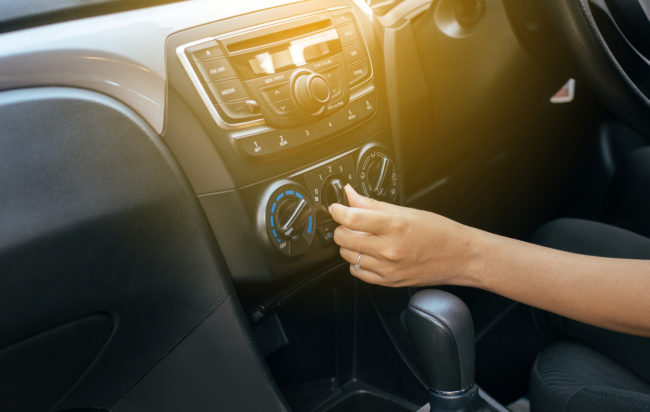
How It Works
The air conditioning system in your car has two key parts. The high-side features the compressor, which moves refrigerant through the system. On the low side, the expansion valve controls the flow by lowering the fluid’s temperature and pressure.
The radiator plays another essential role by reducing the heat generated by the coolant. For this part to function optimally, it must be free of leaks and blockages, and the coolant changed regularly. Otherwise, the fluid becomes acidic, breaking down and damaging your coolant system’s hoses, gaskets and seals. This could also lead to water pump failure.
Heating and Cooling Issues
If you’re experiencing issues with your car’s heating and cooling system, what could be happening?
- Coolant Levels: When there’s not enough coolant, your car might start to overheat. Beyond adding new fluid, check to see if your system is dealing with a leak, a damaged radiator cap or an air pocket.
- Thermostat: As your engine heats up, the thermostat opens and closes the cooling system’s circuits. When it’s stuck, coolant is prevented from circulating. In turn, your car’s heating system fails to perform and your car may start to overheat.
- Heater Core: When it’s performing well, this part lets coolant pass through and supplies warm air through your car’s vents. A clogged heater core does not let coolant flow and heating issues can result. If steam passes through the vents or you see coolant pooling under the dashboard, you’ll need to address the heater core.
- Exhaust System & Ducts: Air passes through from the heater core. If the exhaust system is clogged, your car may begin to overheat.
- Corrosion: Another issue related to the heater core, corrosion eventually causes this part to leak, with sweet-smelling steam and fluid passing through the vents.
Signs of a Heating or Cooling Issue
How can you tell when your car’s heating system has a problem?
- There’s a strange smell – sweet or damp and musty – coming through the vents.
- You don’t feel air coming through the vents, or the car does not seem as cool as usual.
- The air conditioner makes strange noises.
- The windshield and windows fog up when you use the heating and cooling system.
- You spot coolant leaking onto the floor.
- Your car seems to go through more coolant than it used to.
- When you turn on the heat, the car’s interior doesn’t warm up.
- The defroster doesn’t seem to work or takes longer than usual.
- The air conditioner only functions at certain times. For instance, only when the car is stopped.
- Airflow remains low, even when you use the highest setting.
Services & Repairs
Once you experience a lapse in performance, do not wait to bring your car into DaSilva’s Auto Body. What can our technicians do to uncover the cause of your malfunctioning heating and cooling system?
System Inspection
A comprehensive inspection of your car’s heating and cooling system entails:
- Leak tests, using an electronic leak detector, dye detection or combustion test for internal leaks.
- Visual inspection of all belts, caps, hoses, clamps, the water pump and radiator for signs of cracking, drying out, blockages and leaking.
- Checking for signs of overheating.
- Oil and transmission fluid checks, to see if coolant is leaking onto the engine.
- Pressure test on the radiator cap.
- Ensuring the A/C pressure meets the manufacturer’s specifications.
- Testing the interior vent air temperature and coolant operating temperature.
- Performance tests, including a system control test.
Retrofitting
Was your vehicle made before 1993? A system conversion, or A/C retrofitting, may be necessary. The Environmental Protection Agency (EPA) phased out R-12 Freon, which was used in older coolant systems, and replaced it with R-134. These fluids are not interchangeable and the oils present in the new solution will damage your current system’s seals and hoses. Retrofitting – updating seals, hoses and the compressor – ensures your car’s system can handle the newer coolant.
Coolant System Flushes
Rather than a simple coolant top-off, a full system flush may be needed to remove old, debris-filled fluid. Without a flush, this murky, more viscous fluid negatively affects your system, damaging components and impacting its performance. Part of regular heating and cooling system maintenance, this procedure gets rid of any clogs and deposits, replacing the old, ineffective fluid with new, clean fluid.
Has your car been overheating or fails to warm up in winter? It’s time to have the heating and cooling system checked out. Give us a call to schedule diagnostic tests and repairs!





